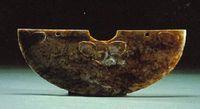 Liangzhu, beautiful water oasis. The Liangzhu Culture, known as "the dawn of Chinese civilization," was first discovered in Liangzhu Town, Yuhang District, Hangzhou, Zhejiang Province in 1936. It dates from about 3300 BC to 2200 BC and is mainly distributed in the Taihu Lake Basin. The Liangzhu Culture Jadeware has undergone a tremendous leap in terms of quantity, type, shape and ornamentation, and production process. It is the first peak in the development history of Chinese jade culture.
Liangzhu, beautiful water oasis. The Liangzhu Culture, known as "the dawn of Chinese civilization," was first discovered in Liangzhu Town, Yuhang District, Hangzhou, Zhejiang Province in 1936. It dates from about 3300 BC to 2200 BC and is mainly distributed in the Taihu Lake Basin. The Liangzhu Culture Jadeware has undergone a tremendous leap in terms of quantity, type, shape and ornamentation, and production process. It is the first peak in the development history of Chinese jade culture. Liangzhu culture jade materials are mostly tremolite, Yangsi stone nephrite, Mohs hardness of about 6-6.5, in addition to vermiculite, serpentine, fluorite and other materials. From the color point of view, the chicken bone is white, the ham is red, the dark green, and the lake green is more common. Sources of jade materials are generally considered to be based on local materials. The imitation products on the market generally use Xiaoyanling of Liaoning Xiuyanyu and Jiangsu Liyang. This reminds jade lovers to screen them.
The Liangzhu culture jade craftsmanship was in a leading position in the prehistoric period. Its expressions include round sculptures, reliefs, openwork carvings, and dense hairy shades. The incisive tools of Liangzhu Jadeware are made of hardened stone tools such as agate, crystal, and obsidian. The so-called "stones from other hills can be used to attack jade" should be derived from this. Jade material cutting line cutting and sheet cutting of two types, the use of wire cutting tools, such as hemp rope, etc. Forming more use of sheet cutting, the tool used for the hardness of the grinding of fine stone tools plus water to solve jade sand, cutting traces were linear. There are two types of drilling techniques: pipe drilling and boring drilling. The use of two-sided drilling methods often results in the formation of misplaced scribe marks, irregular spiral patterns in the holes, soft paving, and more rules for imitations. The spiral pattern and the dry channel form a sharp contrast. The grinding process consists of rough grinding, fine grinding and polishing, three kinds of rough sanding using coarser sandstone tools, grinding down the powder just to solve jade sand; fine grinding using fine stone water plus fine sand particles Grinding; the materials used for polishing cannot be researched today, guessing that it should be a kind of animal skin. Some high-grade tombs of Liangzhu Culture, such as the anti-mountain, jade surfaces unearthed in Yaoshan have a strong glass luster, like a layer of varnish, the level of polishing is exquisite.
Liangzhu culture is rich in jade utensils. According to the use of points, there are ceremonial devices such as cymbals, cymbals, cymbals, etc.; rings, bracelets, tubes, beads, cymbals, hooks, cylinders, conicals, crowns, trifurcations, etc.; and people, fish , cockroaches, birds, turtles and other devices. Imitation of the device type, almost covers all types of Liangzhu jade device, but some imitation for the sake of high profits, painstaking efforts to produce a number of nondescript products, such as the square, triangle, etc., makes people ridiculous.
The Liangzhu culture jadeware is mainly plain, with less ornamentation. There are not many types of ornamentation. The most representative one is the motif motif found on many types of devices - the divine surface pattern. This type of ornament uses the Yin line to engrave the relief method. On the other hand, harmoniously and harmoniously spreads between the square and the square, making people feel that God is above and beyond, and dominate everything in the world, and the world is adored with him. The Liangzhu jade wares with God's face pattern often come from quite high-grade tombs, which are rare in the field of collection and circulation, and they are valuable even if they are. The vast majority of good jade carvings with divine patterns on the market are imitations.
The color of the Liangzhu Culture Jade is generally grey and white, and the chickens are white and white, and the lighter ones are partially translucent. Imitation goods usually have three ways, one is to make the jade material white through high-temperature fire; one is to make gray skin by acid treatment; the biggest lethality is to use the natural chicken ancient white part in the soft stone jade to make, This jade material is natural and difficult to distinguish.
Changxing Xinyang Textile Co., Ltd. , https://www.xinyangtextiles.com